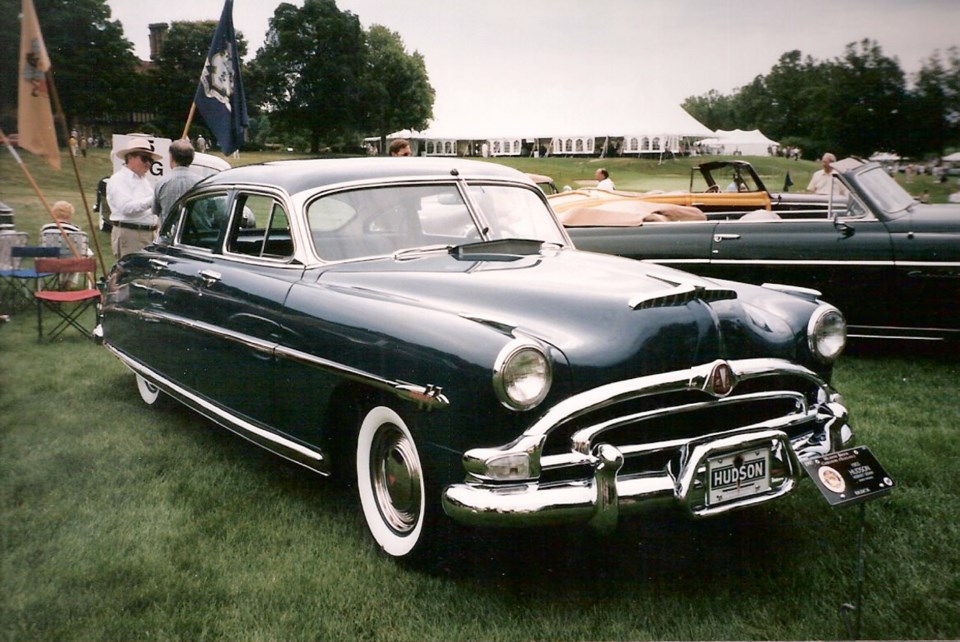The formation of American Motors Corp. through the amalgamation of Hudson Motor Car Co. of Detroit and Nash Motor Co. of Kenosha, Wisconsin, on May 1, 1954, marked the end of real Hudsons. Although AMC continued marketing the Hudson nameplate until 1957, they were basically Nashes. The last generation of genuine Hudsons was built from 1948 to 1954.
Hudson history dated back to 1909, when four ex-Olds Motor Works employees joined to create a car company. The $90,000 start-up funding came from Detroit department store magnate Joseph L. Hudson, so the company and cars were named Hudson.
With the foundersŌĆÖ strong automotive credentials, the new company prospered immediately. By mid-1910, a first-year industry record 4,000 Hudsons were produced. By 1929, annual production surpassed 300,000.
Hudson suffered during the 1930s Depression, but was helped through by nameplates such as the popular-priced Essex and high-performance Terraplane.
During the Second World War hiatus in car building, Hudson produced military equipment such as aircraft parts, naval engines and anti-aircraft guns.
On Aug. 30, 1945, less than four months after VE Day marked the Second World WarŌĆÖs end, Hudson resumed building slightly altered prewar cars to capitalize on the pent-up demand for new cars created by the 1942-to-1945 production hiatus.
When HudsonŌĆÖs sensational new 1948 model appeared in December 1947, its low profile made a major impact. Only 1,534 millimetres high, it was almost 229 mm lower than the ŌĆÖ47 Hudson, and 51┬Āmm lower than the new trend-setting Studebaker.
A 1,956-mm width allowed a 1,626-mm-wide front seat and 1,600-mm rear. The 3,150-mm wheelbase, 76 mm longer than the 1947 models, gave stretch-out legroom.
Hudson achieved its height reduction by lowering the floorpan between the perimeter framing that formed part of the bodyŌĆÖs unit construction. Hudson strongly promoted the safety and convenience of its ŌĆ£Step DownŌĆØ design, and a low silhouette and centre of gravity provided good handling that gave Hudson a significant advantage on the stock car circuits.
Although appearing fat and heavy today, HudsonŌĆÖs styling reflected the then-popular ŌĆ£inverted bathtubŌĆØ school of design. Fenders were fully integrated into the body and the slab-sided appearance was relieved by a mid-body styling line running front to rear.
Along with the new look for 1948, Hudson got a new, sturdier, four main-bearing (previously three), side-valve, 4.3-litre (262 cu. in.) ŌĆ£Super SixŌĆØ engine with full-pressure lubrication. It developed 121┬Āhorsepower, compared with 128 for HudsonŌĆÖs slightly smaller 4.2-litre (254 cu. in.) side-valve inline eight, It raised suspicions that the new sixŌĆÖs power was deliberately underrated to save the eightŌĆÖs prestige.
HudsonŌĆÖs standard transmission was a manual three-speed with available overdrive. Optional was a semi-automatic vacuum-shifted ŌĆ£Drive Master,ŌĆØ or overdrive-equipped ŌĆ£Super-matic.ŌĆØ Gear shifts were accomplished by briefly releasing the accelerator. A fully automatic General Motors Hydra-Matric came in 1951.
The 1948 HudsonŌĆÖs annual sales were 117,200, 42,000 more than in 1947 and the best year since 1929. With few changes for its 1949 40th anniversary, Hudson sales climbed to 159,100.
But the market was becoming more competitive. The Big Three (General Motors, Ford and Chrysler) now had full lines of new models and the pent-up demand was getting satisfied. Hudson again carried its main line over into 1950 with few changes. A new lower-priced Pacemaker helped hold model year sales to 121,408, about 25 per cent below 1949.
HudsonŌĆÖs 1951 Hornet it would prove to be the most famous Hudson of all. With a 5.0-litre (308 cu. in.) 145-horsepower version of the six, and more power easily on tap with the factory ŌĆ£severe usageŌĆØ (read ŌĆ£racingŌĆØ) twin carburetor ŌĆ£Twin-H PowerŌĆØ option, this powerful sturdy engine and stable roadholding let Hornet dominate racing. It would post 80 AAA and NASCAR victories from 1951 to 1955. HudsonŌĆÖs 1951 sales increased to 131,915.
But 1952 marked the beginning of the end for Hudson. Despite the introduction of the new Wasp model on the PacemakerŌĆÖs shorter wheelbase, but with a more powerful 4.3-litre (262 cu in.) six, and the briefly offered Hudson Jet compact, sales fell to 70,000 1952s. In 1953, they slid further to 66,000. Nash and Hudson came together to form AMC on May 1, 1954.
HudsonŌĆÖs decline was caused by severe competition from the Big Three, a shortage of money for new styling, and the lack of a V-8 engine able to fully compete in the horsepower race. Fitting the big six with ŌĆ£Twin-H PowerŌĆØ wasnŌĆÖt enough.
The attrition that eventually swallowed all small independents would remove J. L. HudsonŌĆÖs name from the automotive scene in 1957, by which time they had become little more than disguised Nashes, sometimes derisively called ŌĆ£Hashes.ŌĆØ



